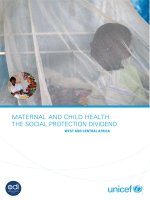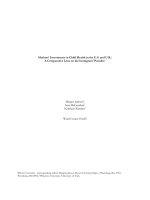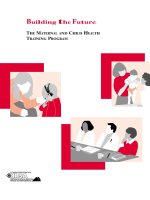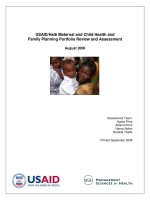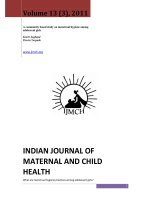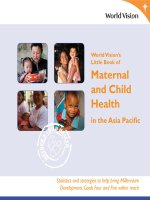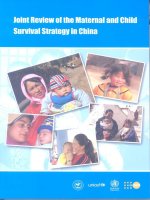World Vision’s Little Book of Maternal and Child Health in the Asia Pacific pdf
Bạn đang xem bản rút gọn của tài liệu. Xem và tải ngay bản đầy đủ của tài liệu tại đây (1.51 MB, 48 trang )
World Vision’s
Little Book of
Maternal
and Child
Health
in the Asia Pacic
Statistics and strategies to help bring Millennium
Development Goals Four and Five within reach
M
O
T
H
E
R
&
C
H
I
L
D
H
E
A
L
T
H
2
© World Vision Asia-Pacic 2009
Stories researched and contributed by
World Vision communicators, 2008/2009
Editing and design: Katie Chalk
Review: Laurence Gray, Dr Sri Chander
To nd out more about World Vision’s
work with maternal and child health in Asia
and the Pacic:
www.wvasiapacic.org
3
Left: Doctor Goat
Thameesha has always suffered from wheezing
and breathing difculties. Since he started
drinking goat milk, he is stronger and his lungs
less prone to asthma or infections. “A villager
told me that goat milk is good medicine,” says
Thameesha’s father. “So with World Vision’s help I
went out and got a male and four female goats.”
While the “medicinal” properties of goat milk
are unconrmed, its nutritional value for children
is very high. Thameesha’s father says since the
goat’s milk was introduced to his children’s diets,
their wheezing has all but disappeared.
Photo: Hasanthi Jayamaha/World Vision Lanka
Contents:
Why health, why now? 4
Who is this book for? 6
Maternal and child health 8
terms and denitions
Part 1: Statistics 10
Part 2: Strategies 18
Part 3: Recommendations 40
References and reading 44
4
An introduction by Watt Santatiwat,
Vice President, World Vision Asia Pacic region
Maternal and child health and nutrition interventions
are complex issues for the Asia Pacic region.
As statistical indicators they measure the health of a
nation and the level of its development. But behind
those statistics are the shadows of many other urgent
development issues - gender inequality, massive wealth
discrepancies, inadequate education or public health
spending, and the tragedy of avoidable deaths through
under-prioritisation of women, children and the poor.
The Asia Pacic region has made some progress in
changing the health of mothers and children for the
better. But we still seriously lag behind in our efforts.
The region still makes up 43% of the world’s total
maternal deaths, and well over 40% of our children are
malnourished.
In our region, 18 of the 29 developing countries are
currently off-track to achieve Goal 4 – to reduce child
deaths by two-thirds, and 23 are off-track to achieve
Goal 5 – to reduce maternal deaths by three-quarters.
In 2010, World Vision will commence advocacy efforts
across the region to encourage solutions at national
Why health, why now?
level on maternal and child health. Each country faces
a different set of challenges, and no country can rest
just yet.
My home country of Thailand, for instance, has shown
what can be possible with appropriate investment of
government funds in its people. Yet even here, in a
country that is often held up as a development model
for others, there is room for improvement. We still see
unacceptable levels of preventable illness and deaths in
marginalised communities, and malnutrition still exists
in our children in both rural and urban areas.
Fighting malnutrition needs to be a priority in all Asia
Pacic countries, not just for children at different
stages of their growth, but also for mothers. Over 30%
of women are malnourished in this region, harming
expectant mothers and reducing the chances of
survival for their children before they are even born.
Spending on health and nutrition needs to be
increased and improved. The Asia Pacic region spends
well below the world average of 5.1% of GDP. In South
Asia only 1.9% is currently spent on health – and one
in every ve children that dies worldwide is an Indian
child.
5
The ADB estimates that additional government
investment of only around $3 per person per year,
spent carefully to target specic healthcare gaps, could
bring the MDGs within reach.
Private sector contribution to health coverage is
a vital component of strategies for meeting MDGs
Four and Five. However, this should not detract
from or replace government responsibility for public
health care. This region is calling out for private and
public collaboration on research, improvement and
promotion of healthier living, in tandem with facilities
and resources to improve the health of mothers
and children in the Asia Pacic’s most vulnerable
communities.
I urge governments and donors in the Asia Pacic to
recognise the way forward on sustainable, equitable
health solutions to protect mothers and their children.
It is at once a humanitarian duty and an investment in
the future resilience of every nation in the region.
Watt Santatiwat
August 2009
This book is for anyone with an interest in maternal
and child health, but in particular for people who can
play a role in strengthening it.
The Asia Pacic has some of the biggest health
challenges of any region. Here, health is a complex
issue, at the heart of community development and
wellbeing and yet held back by resources, attitudes and
traditions. These aspects come together as barriers
to deny fair access to health for more than half the
people living in the Asia Pacic.
As an international NGO with a strong grassroots
approach, World Vision is ideally placed both to deliver
health strategies in under-resourced communities, and
to recognise gaps that cannot be lled without the
support and mobilisation of others.
This book explores some of these gaps, as well as
potential solutions to ll them, by sharing stories
from World Vision’s eld experiences. A single story
may not constitute “evidence” but it can bring unique
insight into challenges, and how current health
practices are missing the mark when it comes to
pro-poor, child-focused protection of lives.
Who is this book for?
Born in a remote village in the district of Xieng Nguen,
Baby Anoi has had his weight and height measured since
birth, and passes the test each time. Despite its relative
poverty, Lao PDR is one of the Asian countries on track
to achieve MDG Four.
The Laos government has announced its commitment
to opening community health centres, providing better
delivery care, immunisations and micro-nutrient
supplements for infants and mobilizing resources to
improve mother and child health. World Vision currently
partners with the government in rural areas to monitor
child health through mobile clinics.
Photo: Albert Yu/World Vision Lao PDR
6
On track: Bangladesh, China, Indonesia, Lao PDR,
Solomon Isl.,Timor-Leste, Nepal, Sri Lanka,
Thailand, Vietnam
Off track: Cambodia, India, Myanmar,
Papua New Guinea, Philippines, Vanuatu
On track: China, Philippines, Solomon Isl.,
Sri Lanka, Thailand,Vietnam
Off track: Bangladesh, Cambodia, India,
Indonesia, Lao PDR, Myanmar, Nepal,
Papua New Guinea, Timor-Leste
7
MDG Four:
Reduce child deaths
(under ve) by two
thirds by 2015
MDG Five:
Reduce maternal
deaths by three
quarters by 2015
Statistics and case studies in this book include only countries where World Vision is working in the Asia Pacic.
The summary above is based on World Vision’s 2009 report “Strategies that Work”:
http://wvasiapacic.org/downloads/publications/StrategiesThatWork.pdf
8
Under ve mortality rate
The probability (expressed as a rate per 1,000 live
births) of a child dying before reaching the age of
ve.
Infant mortality rate
The probability (expressed as a rate per 1,000 live
births) of a child dying before reaching the age of
one year.
Maternal mortality ratio
The probability (expressed as a rate per 100,000
pregnancies) of a woman dying during pregnancy,
childbirth or the rst 42 days after delivery.
Low birth weight
A birth weight of under 2,500 grams. Babies born
with a low birth rate are twenty times more likely to
die than babies born above the minimum weight of
2,500 grams.
Stunting
Measures height against age: usually caused by
long-term insufcient nutrient intake or frequent
infections. Stunting generally occurs before the age
of two; effects are largely irreversible.
Wasting
Measures weight against height in all ages: usually an
indicator of acute food shortage and/or disease.
A high prevalence of wasting usually correlates with
a high under-ve mortality rate.
Underweight
Measures weight against age: the indicator used to
determine malnutrition in children under ve.
Micro-nutrient deciency
Even in a diet where macro-nutrients (carbohydrate,
protein and fat) are provided, a lack of micro-
nutrients can lead to lasting and life-threatening
malnutrition. Common deciencies include iron,
vitamin A and iodine.
Vaccination
Many childhood diseases including measles,
polio, diptheria, tetanus and whooping cough are
preventable through early vaccines. However the
measure of vaccination in statistical terms usually
refers to immunisation against measles by the age of
one year.
Improved water
Access to uncontaminated, contained water sources.
Improved sanitation
Safe disposal of excrement whereby it is separated
from the possibility of human contact (usually means
a toilet).
Maternal and child health terms and denitions
9
Across Asia and the Pacic, World Vision’s child-
focused programmes are partnering at house-
hold, community and national level to:
• Improve standards and increase action around
maternal and child health
• Empower girls and women with the knowledge
to take good care of themselves and their
children, including nutrition, vaccinations, rst aid
and family health responses, and birth spacing
• Encourage governments and international
donors to nd ways to provide affordable, equal
access for all to healthcare, in particular services
for mothers and children under ve
World Vision is working
in nearly 90 countries
worldwide with health
interventions to support the
achievement of Millennium
Goals Four and Five.
Bangladesh
Cambodia
China
DPRK (North Korea)
India
Indonesia
Lao PDR
Mongolia
Myanmar
Nepal
Papua New Guinea
Philippines
Solomon Islands
Sri Lanka
Thailand
Timor-Leste
Vanuatu
Vietnam
World Vision
Asia Pacic region
encompasses:
10
Bangladesh
% children underweight: 41%
Under 5 mortality (per 1000): 61
Living with improved water: 80%
Living with improved sanitation: 36%
Maternal mortality (per 100,000): 320
Bangladesh’s poverty, and the constant setbacks of natural
disasters, challenge its ability to remain food-secure. In
addition, gender inequality, including a lack of priority for
girls’ education, means many mothers lack nutritional
knowledge for themselves or their children.
In Bangladesh today, 500,000 children are diagnosed with
severe acute malnutrition. The maternal mortality ratio
is also high, ranging from 320-380 per every 100,000 live
births. As only around 7% of births are registered, this gure
is an estimate and could easily be higher.
Part 1:
Statistics
All statistics in this section are taken from UNICEF’s
State of the World’s Children 2009 unless otherwise
noted.
11
Cambodia
% children underweight: 28%
Under 5 mortality (per 1000): 91
Living with improved water: 65%
Living with improved sanitation: 28%
Maternal mortality (per 100,000): 470
Despite many years of international aid and
involvement, Cambodia still has the second highest
level of child mortality in the region. Out of every
1,000 children, 91 die before their fth birthday.
Cambodia’s family and community poverty, especially
outside Phnom Penh, prevents many children from
getting both macro- and micro-nutrients they need
to develop normally, while an under-resourced
healthcare system struggles to face up to water-borne
disease, malaria and dengue in children.
Maternal mortality is one of the leading causes
of death for women aged 15-49, with around 470
maternal deaths per 100,000 live births. Eight in
every ten women give birth at home. Only around
40% have skilled help at hand during delivery
2
.
Roughly three quarters of maternal deaths occur in
the immediate post partum period.
China
% children underweight: 6%
Under 5 mortality (per 1000): 22
Living with improved water: 88%
Living with improved sanitation: 65%
Maternal mortality (per 100,000): 41
China has made massive inroads to improve children’s
health over the last fteen years. National statistics,
however, do not necessarily reect the geographical
diversity of this massive country. While government
healthcare reaches most mothers and children in and
around cities, rural communities, ethnic minorities, and
urban migrants are still missing out.
In China, World Vision administers over 30 health
projects in areas of need, with a focus on global health
indicators such as maternal and child health, malnutrition,
tuberculosis, HIV and AIDS, and new and re-emerging
infectious diseases, such as inuenza.
A school breakfast ensures at least one meal a day
has the right nutrition balance for these pre-schoolers
in Guangxi, China
Photo: World Vision China
2. Cambodia Department of Health (CDHS), 2005
12
Indonesia
% children underweight: 23%
Under 5 mortality (per 1000): 31
Living with improved water: 80%
Living with improved sanitation: 52%
Maternal mortality (per 100,000): 310
The diversity of living standards
across Indonesia’s islands is not
necessarily reected in their national
statistics. In urban areas like Jakarta,
micro-nutrient malnutrition affects
the development of children even
in areas with improved healthcare
facilities. Isolated regions are more
likely to suffer from famine or
untreated illnesses, especially malaria
which affects up to 20% of the
population.
Across the country, UNICEF
estimates up to 70% of women and
children are anemic.
India
% children underweight: 43%
Under 5 mortality (per 1000): 72
Living with improved water: 89%
Living with improved sanitation: 28%
Maternal mortality (per 100,000): 300
Despite its recent economic growth,
India’s child health improvements are
markedly behind the goals set by the
MDGs.
In India, the challenges start before
birth. Food shortages affect nearly
350 million Indians. Nine out of ten
pregnant women are undernourished,
20% of infant deaths can be
attributed to anaemia in mothers,
and nearly one third of babies are
born with low birth weight
3
. Only
around 37% of babies are exclusively
breastfed to six months.
These early setbacks leave children
extremely vulnerable to malnutrition,
under-development and childhood
illnesses. One in ve children who
die globally before the age of ve is
Indian.
DPRK
(North Korea)
(Govt. estimates - independent
evaluation not possible)
% children underweight: 37%
Under 5 mortality (per 1000): 55
Living with improved water: 59%
Living with improved sanitation: 59%
Maternal mortality (per 100,000): 110
DPRK is known to have a massive
gap between need and supply of
basic health resources. Government
clinics suffer a chronic shortage
of medicines and vaccinations that
are standard supplies elsewhere
- estimated at only half of what
is required to maintain a healthy
population.
DPRK also faces regular food
shortages, but the situation became
dire in 2008 as oods devastated
harvests, China erected barriers to
food exports, and global food prices
skyrocketed. The WFP projected a
doubling of prices for staples such as
rice, soybeans and maize.
One third of pregnant women are
reportedly under-nourished or
anaemic.
3. WFP statistic: />13
Laos PDR
% children underweight: 31%
Under 5 mortality (per 1000): 70
Living with improved water: 60%
Living with improved sanitation: 48%
Maternal mortality (per 100,000): 410
Humanitarian development is a recent initiative
for Laos; while the current under-ve mortality
rate is still unacceptably high, it is worth noting
that around 20 years ago it was a staggering
170 per 1000 live births. In line with general
improvements in poverty indicators, child health
statistics are improving – but not quickly enough
to meet the goals of the MDGs. Laos still sits at
50 on Unicef’s under-ve mortality rate ranking.
Every day three Lao women die due to maternal
health issues. Only 19% of mothers give birth
with the assistance of a skilled birth attendant,
and less than one quarter (23%) of babies are
exclusively breastfed to six months.
Mongolia
Percentage children underweight: 5%
Under 5 mortality (per 1000): 43
Living with improved water: 72%
Living with improved sanitation: 50%
Maternal death rate; 90
Living standards between country and city
differ widely in Mongolia – while 87% of urban
dwellers have access to improved water, only
30% of rural communities enjoy the same right.
For children living in poverty, access to
appropriate and varied food is also limited;
deciencies in iodine and Vitamin A make
goiters and rickets common and dehabilitating
conditions in Mongolia’s children.
This family in urban Mongolia only eats one meal a day
since rising food costs made basic staples unaffordable.
They make do with tea to replace other meals.
Photo: Enkhbayar Purevjav/World Vision Mongolia
14
Myanmar
% children underweight: 32%
Under 5 mortality (per 1000): 103
Living with improved water: 80%
Living with improved sanitation: 82%
Maternal mortality (per 100,000): 320
Myanmar is the most high risk country in Asia for
children. In Myanmar, at least one in ten children
will die before the age of ve – three quarters of
them before the age of one. At the heart of these
statistics is malnutrition. Only around 15% of children
are exclusively breastfed to the age of six months.
Susceptibility to illness and infection as a result of this
is increased – water-borne diseases, left untreated,
claim many lives, and Myanmar’s malarial deaths
account for around half of those in South East Asia.
Signicant percentages of women suffer maternal
deaths – annually 320 women die per 100,000 live
births. A total 43% of women deliver their child
without any skilled professionals attending.
Nepal
% children underweight: 39%
Under 5 mortality (per 1000): 55
Living with improved water: 89%
Living with improved sanitation: 27%
Maternal mortality (per 100,000): 280
Broad issues of poverty and isolation mean that the
health and wellbeing of Nepal’s children is severely
compromised. A low level of education for many
women means that many mothers do not have an
understanding of good nutrition or the skills to
recognise when their children are dangerously ill or
malnourished.
Malnutrition is considered the underlying cause of
more than 60% of child deaths. As well, the majority
of children do not practice good hygiene habits, like
daily bathing or washing hands after going to the
toilet. Two-thirds of Nepalis do not use a toilet at all.
Around one in 30 women die from pregnancy-related
complications.
Photo: Pamela Sitko/World Vision Myanmar
15
Papua New
Guinea
% children underweight: (no UNICEF
gure available)
Under 5 mortality (per 1000): 65
Living with improved water: 40%
Living with improved sanitation: 45%
Maternal mortality (per 100,000): 370
Papua New Guinea’s capital of Port
Moresby has had much invested in its
infrastructure. In theory healthcare,
clean water and toilets are available
to most, but residents in sprawling
settlements on the outskirts of town
struggle for access to these facilities.
Outside the capital, infrastructure
quickly drops away, leaving
communities with huge challenges in
access to clean water, vaccinations,
improved sanitation or maternal and
child care. The maternal death rate in
Papua New Guinea is approximately
370 in every 100,000 live births.
Approximately 11% of infants born in
Papua New Guinea are underweight.
In rural and highland areas, a priority
is to support communities to
take responsibility for their own
healthcare, by equipping them with
basic knowledge on hygiene, nutrition
and treatment of illnesses like malaria
and diarrhoea.
Philippines
% children underweight: 21%
Under 5 mortality (per 1000): 28
Living with improved water: 93%
Living with improved sanitation: 78%
Maternal mortality (per 100,000): 160
The Philippines could be considered
a success story for Asia in prioritizing
children, their health and their
rights. However, communities living
in poverty, both urban and rural,
may not have the capacity to access
the benets that the government
provides.
Nutrition, especially micro-nutrition,
is still of concern, and tuberculosis
exists in epidemic proportions in
many areas. Community access to
clean water, though at a respectable
level of around 90%, has not changed
markedly since 1990.
Solomon
Islands
% children underweight: 16%
Under 5 mortality (per 1000): 70
Living with improved water: 70%
Living with improved sanitation: 32%
Maternal mortality (per 100,000):140
Despite its restive recent past, the
Solomon Islands is on track to
achieve both MDGs Four and Five.
Health interventions in the Solomons
should now concentrate largely on
preventable diseases, in particular
malaria which is widespread and
deadly. The World Bank reports that
maternal mortality rates appear to
have increased slightly in recent years.
Children at a Child-Friendly Space after Cyclone Nargis in Myanmar receive
a nutritious breakfast. Good nutrition can be a lifesaver post-disaster, where
children suffering existing malnutrition or wasting are extremely vulnerable
to diseases like cholera, gastric infections and malaria.
16
Sri Lanka
Percentage children underweight: 23%
Under 5 mortality (per 1000): 21
Living with improved water: 82%
Living with improved sanitation: 86%
Maternal mortality (per 100,000): 43
A concerted effort over 40 years
of public healthcare to improve the
standards of maternal health has paid
off, with Sri Lanka now able to report
a maternal death rate around 1/10th
of that of countries like Cambodia or
Papua New Guinea. A total of 98% of
births take place in a medical facility.
However, Sri Lanka’s children suffer
from a high level of malnutrition,
caused in part by a lack of knowledge
on the benets of breastfeeding and
under-two nutrition requirements.
Malnutrition is particularly prevalent
in the children of Sri Lanka’s tea-
planting regions, born into the
families that live and work on the
estates.
The state of children’s health in Sri
Lanka is set to worsen as a result
of massive displacement, which has
disrupted health services in affected
areas, and rapidly rising food costs in
the country’s capital Colombo.
Thailand
% children underweight: 7%
Under 5 mortality (per 1000): 7
Living with improved water: 98%
Living with improved sanitation: 96%
Maternal mortality (per 100,000):12
Overall, Thailand’s food security and
child health needs have been met
with committed determination from
its government. Maternal deaths are
among the lowest in the region and
the under-ve mortality rate reects
a high level of protective health
interventions for this age group.
Problems exist mainly in isolated,
unrecognized or marginalized
communities, especially in hill tribes
along border areas and in large
Burmese migrant populations. Health
and nutrition awareness programmes
are vital to protect the children of
these communities from avoidable
malnutrition or infections, including
tuberculosis.
Dilsia, six and recovering from moderate
malnutrition, has her arm measured for
signs of wasting at a nutrition group in
Lequidoe, Timor-Leste
Photo: Katie Chalk/World Vision Timor-Leste
17
Timor-Leste
% children underweight: 46%
Under 5 mortality (per 1000): 97
Living with improved water: 62%
Living with improved sanitation: 41%
Maternal mortality (per 100,000): 380 (adjusted)
Timor-Leste remains extremely under-developed, and the
effects of this are seen in the health of its children. Nearly
half of them are suffering from some form of malnutrition,
making them very susceptible to childhood illnesses. Food
shortages in East Timor regularly impact more than one
third of the population. In 82% of cases women do not
have skilled professionals attending the delivery of children.
Timor-Leste’s birth rate of over seven children per family
contributes further to the problem; mothers are often
malnourished themselves and family incomes cannot meet
their children’s health needs.
Vanuatu
% children underweight: 20-25%
4
Under 5 mortality (per 1000): 34
Living with improved water: 60%
Living with improved sanitation: 50%
Maternal mortality (per 100,000) 68
Though a small country in population, Vanuatu is made
up of 83 different islands. Around 20% of the population
have no access to healthcare whatsoever. Planning for
support of Vanuatu’s maternal and child health should take
into account the need for basic infrastructure as well as
interventions specic to neonatal care.
Vietnam
Percentage children underweight: 25%
Under 5 mortality (per 1000): 17
Living with improved water: 85%
Living with improved sanitation: 61%
Maternal mortality (per 100,000) 160
Vietnam’s rapidly improving economy has allowed it to
provide better health services to its people, but the gap
between urban and rural living standards is vast. Especially
at risk are ethnic minorities, who are still missing out on
targeted public health interventions.
While child mortality is comparatively low, one quarter
of children are underweight – a problem linked to
malnourishment in their mothers and a low level (17%) of
exclusive breastfeeding to the age of six months.
There are a reported 160 maternal deaths per every
100,000 live births in Vietnam, and over 40% out of all
pregnant women are anaemic.
5.
4. AUSAid gures:
5. UNICEF statistic: />18
Part 2:
Strategies
19
Objective:
Improve maternal survival
Objective:
Improve child survival
Objective: Improve
maternal and child nutrition
• Strengthen communities to respond to preventable
children’s diseases
• Strengthen childcare to reduce accidents and
neglect
• Increase under-ve focus of MDG Six to reduce
malaria, TB and HIV and AIDS
• Improve access to quality ante-natal and neo-
natal services in remote areas
• Increase community knowledge and commitment
to maternal health
• Include maternal health care in emergency
responses
• Ensure mothers know benets of exclusive
breastfeeding and an appropriate diet
• Inform and involve children
• Encourage mothers to recognise and share their
child health achievements
20
Parbati cuddles her newest baby girl,
Karuna, aged around three months.
Photo: Pratigya R. Khaling/World Vision Nepal
21
The grief of Deepak’s loss was not healed properly for
Parbati before she bore another child, a boy, Maila, who
resembled Deepak but also passed away at the age of
two.
Parbati says, “Despite everything I tried, I couldn’t save
him. My mother in law tried her hand with all kinds of
traditional healers. They also failed and told us to take
him to a hospital. My husband worked more hours than
ever before then and made some money but I guess it
was too late. Maila also died in front of my eyes.”
Parbati, now 35, has had three more children, a surviving
son and two more daughters. She is terried of ill health,
because until recently she has had no way to understand
it or address it.
Parbati says, “I have such a big family. We have no savings.
If anyone falls sick in the family, we do not have extra
money for treatment. That is how we lost our two
sons.”
Objective: Improve child survival
Growing up in a village in Nepal, Parbati never went
near a school. She began doing the household chores
when she was around ve or six; was working before
she was ten; married and pregnant before she was 20.
Parbati’s rst two children were daughters, both family
disappointments in a culture with such large gaps in
gender equality that female children, and sometimes
their mothers, are reportedly still murdered. Parbati was
mistreated and often went without food, even when she
was breastfeeding.
A little glimpse of hope in Parbati’s miserable life,
her third child was a son. They named him Deepak
– meaning light. But this happiness was short-lived.
Deepak, at the age of three, passed away.
Parbati recalls, “Deepak was a very small baby. His legs
and arms were really thin. He couldn’t breathe properly.
One night his body became as hot as re. We had no
money to take him for treatment. When we tried to
borrow money from neighbours, no one was willing to
lend us any. It was very difcult for Deepak to breathe,
and all of a sudden he just stopped.”
22
In the tea plantation area of Ambagamuwa, Sri Lanka, World
Vision has helped the Ministry of Health go mobile. By
providing transport to isolated areas and negotiating for
use of community or estate buildings, they have made it
possible for a monthly government clinic to provide pre-
and ante-natal checkups, monitoring of children’s weight
and health and general medical advice.
Patients are checked by Dr. Ragunath from Jaffna who has
been working in the estate sector for the past 20 years.
Ministry of Health midwife, Kamala, says that many of these
women would nd it too difcult to attend a clinic further
away, because they need to work or because they cannot
afford the bus fare to get there.
“Anaemic conditions are very common in these young
mothers and their babies. Almost all who visit this clinic are
estate labourers. They have no knowledge about nutrition.
They get through the day on plain tea and roti. And now
through the clinic we have made them aware of their
conditions and taught them what could be done.”
Local women working as World Vision mobilisers are very
involved in the clinic arrangements every month. They visit
every house in the area and inform them beforehand of
the clinic day. They also come on the day in case language
becomes a barrier to accurate diagnosis or advice.
Strategy: Strengthen communities to
respond to preventable children’s diseases
Kamala is pleased to report that the children are
healthier. “When the clinic was rst started two years
ago, we found a lot of children who had not received
a single vaccination since their birth. So we had to
start right from the beginning.”
“Since then, we have seen a positive increase in the
interest of the mothers in their children’s health.
Every month the clinic is packed with over 50
mothers.”
Photo: Katie Chalk/World Vision Lanka
23
Child health is not always linked to clinics, vaccinations,
medicines or diet. Nearly 10% of child deaths in the
Asia Pacic occur as a result of accidents.
Left alone at home while their labourer parents work
all day, these girls and millions like them are extremely
vulnerable to accidental injuries and limited in their
knowledge or ability to seek treatment.
Photo: Alina Shrestha/World Vision Nepal
Strategy: Strengthen childcare
to reduce accidents and neglect
24
Malaria is one of the highest
causes of death for children
in Papua New Guinea,
misunderstood and under-
prioritised by communities. At this
distribution of pyrethrum mosquito
nets, mothers also received clear
directions on their usage and life-
saving household health practices
to recognise and reduce the
symptoms of malaria.
Photo: Gary Fagan/
World Vision Pacic Development Group
Strategy: Increase under-ve focus of MDG Six
to reduce malaria, TB and HIV and AIDS
25
Judith Agyam, a TB Task Force member
in Davao City, Philippines, walks home
with daughter Emelyn after helping fellow
Task Force members conduct a class
on tuberculosis in her home village in
Malabog.
Located nearly 25 kilometres away from
town, Malabog can only be reached
after more than one hour of trekking
through the mountains. Judith helps her
neighbours with TB symptoms to get
proper consultation in the nearest health
centre in town.
The TB Task Force is a community-based
volunteer group organised by World Vision’s
Social Mobilisation on TB (SMT) Project
to help TB prevention and control in the
country.
Photo: Maria Soccoro Melic

